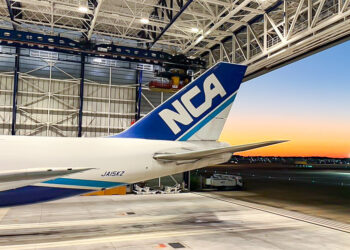No products in the cart.
Alaska Air Cargo’s three 737-700Fs flying high, considers adding more

Better late than never, Alaska Air Cargo took re-delivery of its first Bedek-converted 737-700BDSF about two years later than originally expected in September 2017. The first -700F entered commercial service on 27 September 2017, and as of March 2018, the Seattle-based carrier was operating all three -700BDSFs it had on order with Bedek. Looking ahead, Jason Berry, managing director cargo, recently told Cargo Facts during a visit to the company’s cargo hub in Seattle that the new additions to Alaska’s freighter fleet are fitting in so well that Alaska is considering adding a fourth freighter.
As an operator of 737-700 passenger aircraft, Alaska did not have to look far find feedstock for its first three 737-700 conversions. Feedstock for a fourth aircraft would also be sourced from the carrier’s passenger fleet, which currently includes 11 of the type. The three -700Fs have now replaced Alaska Air Cargo’s historic fleet, which as of January 2017 included five 737-400 combis and a single 737-400F. The combis were gradually retired by October 2017, while the lone 737-400F was returned to the lessor in March 2018.
Berry and the Alaska Air Cargo team’s excitement at the arrival of the -700Fs was at a level on par with chefs receiving their first shipment of Copper River Salmon of the season. For a brief period last summer, Alaska’s -400F was in maintenance, leaving the carrier without any maindeck capacity. In some cases, this meant flying 737-800 passenger aircraft between Seattle and Alaska, without any passengers on board. With three freighters in operation, those days are gone.
Even though the complete triad of -700Fs has only been in operation for two months, the carrier is seeing some promising, perhaps even record-breaking numbers. The freighters primarily operate in scheduled service between Seattle and Alaska, and intra-Alaska, with utilization averaging 10.5-hours per day – quite a feat for a narrowbody freighter. Reliability, meanwhile, is approaching 99%, which is an improvement over the now retired 737-400F.
If three freighters don’t provide enough additional capacity for one year, Alaska Airlines is preparing to significantly increase the volume of belly capacity it has on offer across its US domestic network. Later this month, on 19 June, Alaska plans to begin marketing capacity on the 70 Airbus A320/321 aircraft it acquired as part of its takeover of Virgin America. Unlike many past mergers, Alaska’s acquisition of Virgin America is unique in the sense that the latter did not carry cargo. “It’s all new capacity for the industry to fill”, said Rick Bendix, manager marketing & business development, Alaska Airlines Cargo.
At present, the carrier’s cargo operations are very Alaska-centric, with 70% of what it carries touching the state of Alaska in some way. Although the top-priority will always be to ensure a steady supply of perishables, mail, and other precious cargoes to Alaskan communities, and a direct link to markets in the lower 48 for Alaskan goods, Berry said. The team is also looking at freighter operations within the lower 48. Noting how many airports in Alaska restrict nighttime flights, Berry sees opportunities for overnight freighter flights between Seattle and Los Angeles. A fourth freighter meanwhile, would enable uninterrupted scheduled freighter services while opening the door to additional charters or scheduled services in the lower 48.
And now for a few photos of one of these “new” birds in action:









